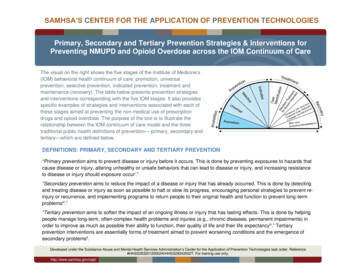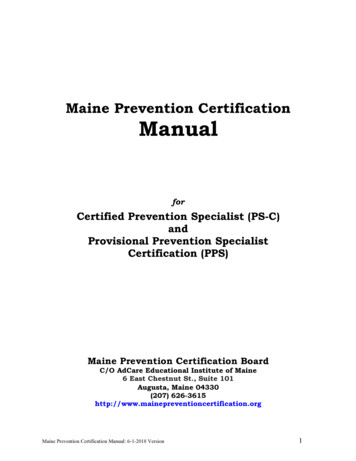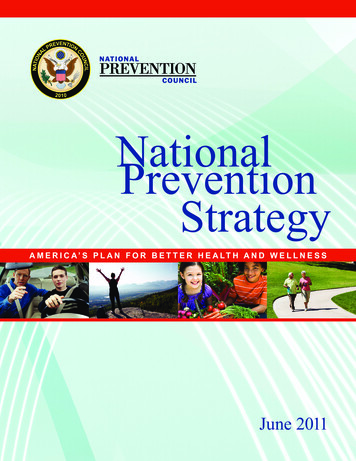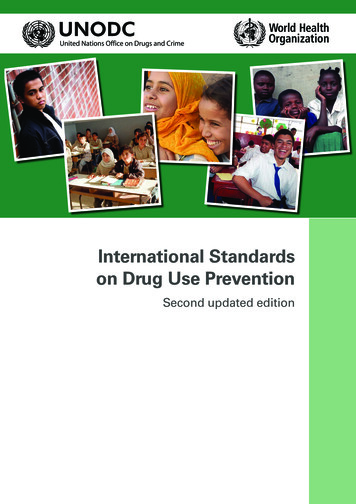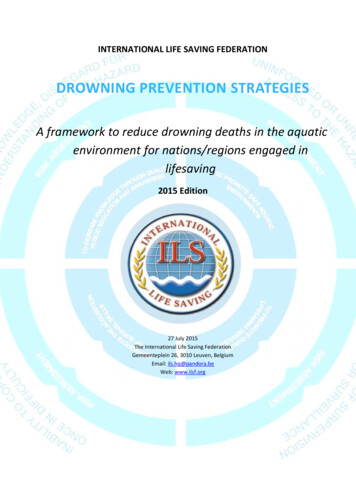
Transcription
INTERNATIONAL LIFE SAVING FEDERATIONDROWNING PREVENTION STRATEGIESA framework to reduce drowning deaths in the aquaticenvironment for nations/regions engaged inlifesaving2015 Edition27 July 2015The International Life Saving FederationGemeenteplein 26, 3010 Leuven, BelgiumEmail: ils.hq@pandora.beWeb: www.ilsf.org
Page 2 of 98Drowning Prevention Strategies – International Life Saving Federation
CONTENTSINTERNATIONAL LIFE SAVING FEDERATION . 12015 Edition . 1Preface . 5The International Lifesaving Federation . 5The Rescue Commission . 5Drowning Prevention and Public Education Commission . 6The Rescue Operations and Education Committees . 6Forward – How To Use This Information . 7Working together we can make a difference. 7Executive Summary . 8Background . 10What is “Drowning” (a definition) . 10What is known about world drowning? . 10The cost of drowning . 11The cost of prevention. 11Contributing factors. 12Contributing factors include age, gender, supervision, ethnicity, and medical conditions. 12Drowning deaths across the various life stages . 12Partnering with other organisations. 13Evidence based principles . 13Preventative Measures . 14Primary Measures . 15“Rescue agencies often refer to these activities as ‘indirect interventions’.” . 15Secondary Measures . 15Tertiary Measures. 16Prevention programmes should take into consideration: . 16Death by drowning can be reduced . 16The Drowning Prevention Chain . 18The role of risk assessments . 18“Chain” . 19Pictorial Representation of the Drowning Chain . 19Aligning the Drowning Prevention Chain with the WHO Global Report on Drowning . 20The Drowning Prevention Chain – Summary of Control Measures . 22Factor One – Lack of Knowledge, Disregard or Misunderstanding of the Hazard . 23Factor Two – Uninformed, Unprotected or Unrestricted Access to the Hazard . 55Factor Three – Lack of Supervision . 61Page 3 of 98Drowning Prevention Strategies – International Life Saving Federation
Factor Four – Inability to Cope Once in Difficulty . 78Appendix - Risk Assessment . 90Principles . 90Framework for the endorsement of risk assessment . 90Key stakeholders both internal and external are identified and engaged . 90Identify any historical data and statistics . 90Establish the operational environment . 91Determine what can happen . 91Establish a ‘risk score’ . 91Conclusions . 92Recommendations. 93Organisations Interviewed . 94Acknowledgements . 96The ILS Rescue Committee . 96The ILS Education Committee . 96Acknowledged for their contribution to the 2008 ILS Drowning Prevention Strategy . 96Research and interview team . 97Peer Review Team . 97References . 98Page 4 of 98Drowning Prevention Strategies – International Life Saving Federation
PREFACEThe International Life Saving Federation (ILS) is reviewing drowning prevention strategies. This thirdedition of Drowning Prevention Strategies, A framework to reduce drowning deaths in the aquaticenvironment for nations/regions engaged in lifesaving, reviews strategies that have been introducedthwithin member federations. The first edition was published on 10 July 2008 with the second and thirdeditions adding and updating additional strategies following a review by ILS member organisations.The framework articulated within this document has been developed from the perspective of developednations/regions with well-developed lifesaving practices. In providing a snapshot of key drowningprevention strategies from around the world this knowledge can be shared between nations andprograms developed in one country can save lives in another.ILS will further explore strategies and frameworks from the perspective of developing nations/regions,and if applicable, integrate the findings into a comprehensive drowning prevention strategy/framework.THE INTERNATIONAL LIFESAVING FEDERATIONILS is a global, non-profit federation of over 100 national lifesaving organisations around the world. ILSleads the worldwide effort to reduce injury and death in, on, or around the water. The vision of the ILS isi”a world free from drowning” . The ILS pursues this vision through the work of its member lifesavingorganisations and by delivering on the strategic goals of the organisation contained within the ILSStrategic Framework 2012-2015: Build the capacity to reduce drowning within targeted communities;Position ILS as the world authority of drowning prevention, lifesaving and lifesaving sport;Reduce the drowning of children globally through partnership and collaboration;Expand the scope, reach and recognition of lifesaving sport;Create a sustainable business model;Establish and promote global best practice; and,Engage with every nation.THE RESCUE COMMISSIONThe Rescue Commission (one of four ILS commissions) works to reduce the incidence of drowning andaquatic injuries throughout the world: through the development of organised lifesaving in areas of the world where it does not existsupport for existing lifesaving organisationssupport for standardised public information and educationtracking the incidence of drowning throughout the world and publishing this datadevelopment and identification of best medical practicesreviewing, identification, and development of best practices in rescueidentification of best practices in the training, staffing, and equipping of lifesaversPage 5 of 98Drowning Prevention Strategies – International Life Saving Federation
DROWNING PREVENTION AND PUBLIC EDUCATION COMMISSIONThe ILS Drowning Prevention Commission provides leadership in the global effort to prevent drowningwith an emphasis on reducing drowning of children, in developing countries, regions and populations withhigh drowning mortality and drowning as a result of aquatic disasters. The Commission will achieve thisby; leveraging the drowning prevention expertise of the ILS and member federationsproviding evidence and information about drowningleading collaborations that aim to reduce global drowningadvocate for the issues that reduce global drowningestablishing an ILS Global Drowning Prevention or Reduction Network consisting of the people,products, processes, research, thinking and knowledgeTHE RESCUE OPERATIONS AND EDUCATION COMMITTEESThe Rescue Operations and Education Committees are two of four sub-committees of the RescueCommission.The purpose of the ILS Rescue Operations Committee is to bring together leading internationalpractitioners and subject matter experts on lifesaver rescue operations to enhance the quality oflifesaving and drowning prevention activities throughout the world through identification of best practice,development of recommended minimum standards, encouraging adherence to these standards, anddissemination of lifesaving information in the area of lifesaver rescue operations, thereby assisting inpositioning the ILS and Member Organisations as the world authorities on lifesaver rescue.The purpose of the ILS Education Committee is to bring together leading international practitioners andsubject matter experts on lifesaver education to enhance the quality of lifesaving and drowningprevention activities throughout the world through identification of best practice, development ofrecommended minimum standards, encouraging adherence to these standards, and dissemination oflifesaving information in the area of lifesaver education, thereby assisting in positioning the ILS andMember Organisations as the world authorities on lifesaver education.Drowning Prevention Strategies, A framework to reduce drowning deaths in the aquatic environment fornations/regions engaged in lifesaving, was developed by the ILS Rescue Operations Committee inconjunction with the ILS Education Committee from the perspective of lifesaving rescue and education.Page 6 of 98Drowning Prevention Strategies – International Life Saving Federation
FORWARD – HOW TO USE THIS INFORMATIONThe International Life Saving Federation (ILS) has developed a framework to assist nations andorganizations to provide the best response to drowning reduction. This framework can be used in morethan one way and the choice of how it is used depends on the setting and identified issues within a targetpopulation.For nations/regions with established lifesaving organisations and an effective drowning reductionprogramme, the framework is intended to assist in the fine-tuning of the drowning prevention strategiesemployed. The programmes and strategies that are currently in place should be listed against the sectionof the framework that they relate to. The planner can then identify gaps in drowning preventionstrategies and refer to the lists of strategies that are in place elsewhere in the world. It is intended that aplanner can follow the links in the Drowning Prevention Strategy framework back to the source countryand collect the detail of how each strategy or programme is applied there. The objective is to refine therange of activities that are used to further reduce the incidence of death by drowning.For nations/regions without an established drowning prevention or lifesaving organisation, theframework identifies the factors that cause people to drown and provides evidence-based measuresregarding prevention and treatment. The document breaks out the causes and the broad responses thatcan be made for each cause. To help you establish a Drowning Prevention Strategy, there are lists ofresponses presented that have been used in other nations/regions to deal with each cause. Not all ofthese will be appropriate in your country, but considering all the possibilities should help you to refineyour thinking. In most cases, links have been provided to the country of origin, so you get the opportunityto consider the context in which the strategy or programme was developed, as well as the detail of how itworks.It is helpful to understand the drowning problem and at-risk populations. The research will assist indetermining the target and prevention strategies that would be most effective.Highest priority should be assigned to active measures to prevent drowning death that are evidencebased; that is, that have been shown to succeed when used by a population most similar to the targetpopulation.If you need assistance with this process at any time, you should follow this link (www.ilsf.org) to makecontact with staff and volunteers who advocate and focus on Drowning Prevention, or consult withexperts on the commissions, committees and working groups.Working together we can make a difference.Page 7 of 98Drowning Prevention Strategies – International Life Saving Federation
EXECUTIVE SUMMARYThe World Health Organisation (WHO) Guidelines for safe recreational water environments suggest that"recreational water activities can bring health benefits to users, including exercise and relaxation.Effective management can control potential adverse health consequences that can be associated with theuse of unsafe recreational water environments. Different stakeholders play different roles in themanagement of the recreational water environment." Use of guidelines, such as those available throughWHO, can aid in ‘the development of approaches to controlling hazards that may be encountered iniirecreational environments.’The ongoing goal of the International Life Saving Federation (ILS) is to reduce death by drowningworldwide. Most importantly, ILS will assist in the development of control measures (interventionstrategies) to employ scarce resources toward the most effective drowning intervention strategies. Theultimate goal is a meaningful reduction in the incidence of drowning worldwide.Death by drowning is a serious threat to world health. United Nations world population projectionssuggest that we can anticipate that the drowning problem is going to get worse without significantiiiintervention, especially in developing countries.As the world water safety organisation, ILS has an obligation to take a lead role in defining and articulatingsolutions to reduce the drowning problem. ILS will provide leadership in communicating the nature andscope of the world drowning problem and provide guidance to member organisations, governments andpartners concerning solutions to the drowning problem.Identifying the contributing factors allows ILS to provide effective prevention actions to the highest riskpopulations, locations and activities via its member federations. ILS plans to update these strategies withregular frequency. ILS will work with its member organisations and others to assist in finding effectivesolutions to assist in the reduction of drowning, either as a national project or as a development aidprogramme.Drowning Prevention Strategies, A framework to reduce drowning deaths in the aquatic environment fornations/regions engaged in lifesaving, 2008 and subsequent editions will assist member federations indeploying their resources for the most effective drowning control measures aimed at high-risk targetgroups.Prevention programmes in the most developed nations/regions should encompass strategies to addressthe needs of high-risk target groups and focus on: Environmental modification: removing hazards or creating barriersProtecting those at risk: promoting change in risk-taking supervision;Promoting swim and lifesaving skills developmentTraining the general community in water safety and resuscitation.Provision of trained lifeguards to conduct patron surveillance and supervision at aquatic facilitiesivand beach areas“USLA data during 1988-1997 indicate that more than three-quarters of drowning at USLA sites occurredat times when beaches were unguarded and that the chances of drowning at a beach protected byvlifeguards trained under USLA standards is less than one in 18 million.”Page 8 of 98Drowning Prevention Strategies – International Life Saving Federation
Prevention programmes in the less developed nations/regions should encompass strategies that focus onthe establishment of primary education and public health systems, because these serve to save lives byincreasing literacy and awareness. This also enhances the economic and health capacity of thepopulation. Drowning prevention strategies in these settings will be social adaptations such as theprovision of day care, and the provision of structured school. Social change strategies are effective forunintended injury reduction, including drowning prevention.Interventional strategies are most effective when they are conceived, enacted and researched byculturally sensitive persons (native/local leadership) from within the target nation, population, and region.To that end, it is important to have such interventional strategies be systematic, substantial, sustainedand service-linked. For that approach will serve to build internal empowerment and expand capacity andconfidence for those same strategies within the nation/region.This document is not meant to imply that a control measure listed her for one nation/region will have thesame impact in another nation/region. This document is designed to list ideas that have worked indifferent parts of the world that may assist in developing strategies to prevent drowning in othernations/regions. ILS is not attempting to dictate what the needs of the nations/regions are or should be.Instead, ILS encourages all nations/regions to decide for themselves what those needs are and,accordingly, how best to meet them. The purpose of this document is simply to offer some ideas thathopefully may be helpful.More importantly, the reader should note that this document has been produced by the ILS Rescue andEducation Committees through the lens of well-established lifesaving nations. ILS acknowledges thatsignificant work needs to be done to understand and articulate appropriate control measures to assistdeveloping nations. This work is currently being scoped by the ILS Drowning Prevention Commission.Control measures work. This document is the first step in setting out a range of control measures that willassist in reducing death by drowning in developed nations/regions.Page 9 of 98Drowning Prevention Strategies – International Life Saving Federation
BACKGROUNDWHAT IS “DROWNING” (A DEFINITION)Drowning is “The process of experiencing respiratory impairment from submersion/immersion in liquid”.Where that impairment leads to death, we note that the person has drowned. This report sets out controlmeasures that both reduce the likelihood of a person experiencing “drowning” and more importantly,videath by drowning.WHAT IS KNOWN ABOUT WORLD DROWNING?In 2002, WHO reported a review of drowning based on data from the year 2000. These global burden ofdisease (GBD) figures underestimate drowning deaths since it excludes drowning due to disasters and,transportation accidents. The data from some nations/regions was modelled to estimate the globalburden of drowning death. Even while acknowledging that drowning deaths are significantlyunderreported, WHO identifies drowning as the third leading cause of unintentional injury death afterviimotor vehicle collisions and falls. WHO estimated 409 272 people died from drowning in 2000.viiiThe first World Drowning Report published by ILS in 2007 includes an analysis of data from 16 MemberOrganisations, identifies drowning trends, factors and high-risk groups and is consistent with that of theWorld Health Organisation Factsheet on Drowning.ixUNICEF published Child Mortality and Injury in Asia in 2007. This series summarizes the finding of 6national and sub-national surveys in Asia, in Bangladesh, China, Philippines, Thailand and Vietnam. Theresults show that traditional health system data misses most injury deaths in this region. Death bydrowning, greatly under-estimated using traditional methods of reporting, is the leading injury cause,being responsible for over half of all injury deaths in children. These surveys show that injury claims asignificant share of the 10.5 million deaths reported in children under-five. Over ½ of all deaths under age18 are due to injury. In Bangladesh 29% of the classifiable mortality age 1-4 was caused by injury.Drowning is the overwhelming cause of fatality in this age group.The ILS Strategic Planning Session in Porto, Portugal in September 2007 showed that most death bydrowning in developing countries is unrecorded by health information systems. As a result, in 2007 bestestimates were that at least nine out of ten people who drown globally occur in the developing world.Most of these are in children under 18 years old and the largest portion is in children under five years old.The newest evidence shows that death by drowning is a public health epidemic on a global scale.In 2014, the WHO Global Drowning Report clearly identified prevention as vital in relation to drowningsince “once someone starts to drown, the outcome is often fatal”. This landmark report also places themost recent figure on the annual global drowning toll at 372,000 people with more than 90% of thesedrowning deaths occurring in low- and middle-income countries. The WHO report also places drowning inthe top “10 leading causes of death amongst children and young people in every region of the world, withxchildren aged under 5 years disproportionately at risk”.Page 10 of 98Drowning Prevention Strategies – International Life Saving Federation
THE COST OF DROWNINGUnintentional death by drowning and non-fatal drowning incidents place a burden on society, both inhuman terms (loss of life, loss of quality of life, pain and suffering) and also direct costs to society(treatment and ongoing care along with lost productivity due to death or incapacity).“In America, the National Safety Council (1997) sets the economic cost of an accidental death at US0.8million. Included in the components of the economic loss are wage and productivity losses, medicalxiexpenses, administrative expense, legal fees and insurance, and employer costs.”“Australian studies examining the cost of unintentional drowning deaths estimate an average costxiibetween A0.6 and A1.6 million per person.”A further study by The Allen Consulting Group in Australia, Valuing an Australian Icon – The Economic andSocial Contribution of Surf Lifesaving in Australia (2005), noted that the Australian Institute of Criminologyxiii(in 2004 terms), valued a life at A1.7 million.A study by PricewaterhouseCoopers in New Zealand, “Valuing the Benefits of Lifeguarding” (2003), notedxivthat the value attributed to a statistical life is NZ2.6 million.A study by Mintel Group in the UK, The Economic Value of Lifeguarding, A research study exploring thevalue of providing lifeguarding services in the UK (2007), determined that the economic cost of death byxvdrowning as GBP 2,109,486 and the comprehensive cost GBP 3,085,850.While the estimates vary according to the underlying assumptions, it is clear that the burden placed onsociety in developed nations/regions is large. The methodology adopted is largely based on productivecapacity and taxation. It is not so clear what the methodology within the developing nations/regionswould show, or indeed whether the methodology is relevant. When a child dies by drowning there is asignificant social and economic impact to a family and a community. When an adult dies by drowning thismay result in orphan children and reduced capacity to support the remaining family These costs areunquantifiable.THE COST OF PREVENTIONThe costs of different styles of prevention program is varied. More research is needed to truly understandthe costs of prevention, as well as the costs of injury and mortality. The UNICEF report on Child Mortalityxviand Injury in Asia , has explored the cost of injury mortality and the association with poverty. Throughconducting a household survey, collecting important information on household injury and mortality,across a large population and utilising local resources the authors found that this data could be collectedat significantly lower costs, approximately 2 per household, than other Demographic and Health Surveys.This is less than the cost of accepted immunization programmes.More research is needed to accurately gauge the coasts of prevention, by building on the platform of themethodologies published by UNICEF this could be completed in a cost effective manner.Page 11 of 98Drowning Prevention Strategies – International Life Saving Federation
CONTRIBUTING FACTORSContributing factors include age, gender, supervision, ethnicity, and medical conditions.Many studies show that males are more likely to drown than females due to risk taking behaviour, andunder estimation of the hazard. The WHO (2014) estimate that “males twice as likely to drown asxviifemales”.In developed nations/regions, alcohol is often associated with drowning deaths and increases thelikelihood of immersion resulting in drowning when recreating around water. Not wearing a personalfloatation device or lifejacket when required to do so (such as boating, rock fishing etc) has also beencited as a contributing factor to unintentional death by drowning.In developing nations/regions, drowning deaths can result from the effects of illiteracy and ofovercrowding on poorly equipped water craft. The combination of risk-awareness education and watercraft regulations may help to significantly reduce the number of such drowning deaths. Awarenesseducation and water craft regulations may be a powerful influence to reduce drowning deaths.Alcohol has also been identified as an important risk factor when used on or around water and has beenshown to be a contributing factor in many drownings involving adolescents and adults in manyxviii, xixcountries.DROWNING DEATHS ACROSS THE VARIOUS LIFE STAGESDifferent physical capabilities, interests, influences and maturity bring different challenges and risksassociated with drowning. In order to prevent death by drowning, and water related injuries, we need totarget people at each stage of life in different ways. This means that different intervention strategies mayxxbe needed for people of different ages. For example, Life Saving Victoria has the following preventionprogrammes available for people of different ages.Table 1: A life stages approach to drowning prevention.AgeInfants and Toddlers(Age 0
Drowning Prevention Strategies - International Life Saving Federation EXECUTIVE SUMMARY The World Health Organisation (WHO) Guidelines for safe recreational water environments suggest that "recreational water activities can bring health benefits to users, including exercise and relaxation.



